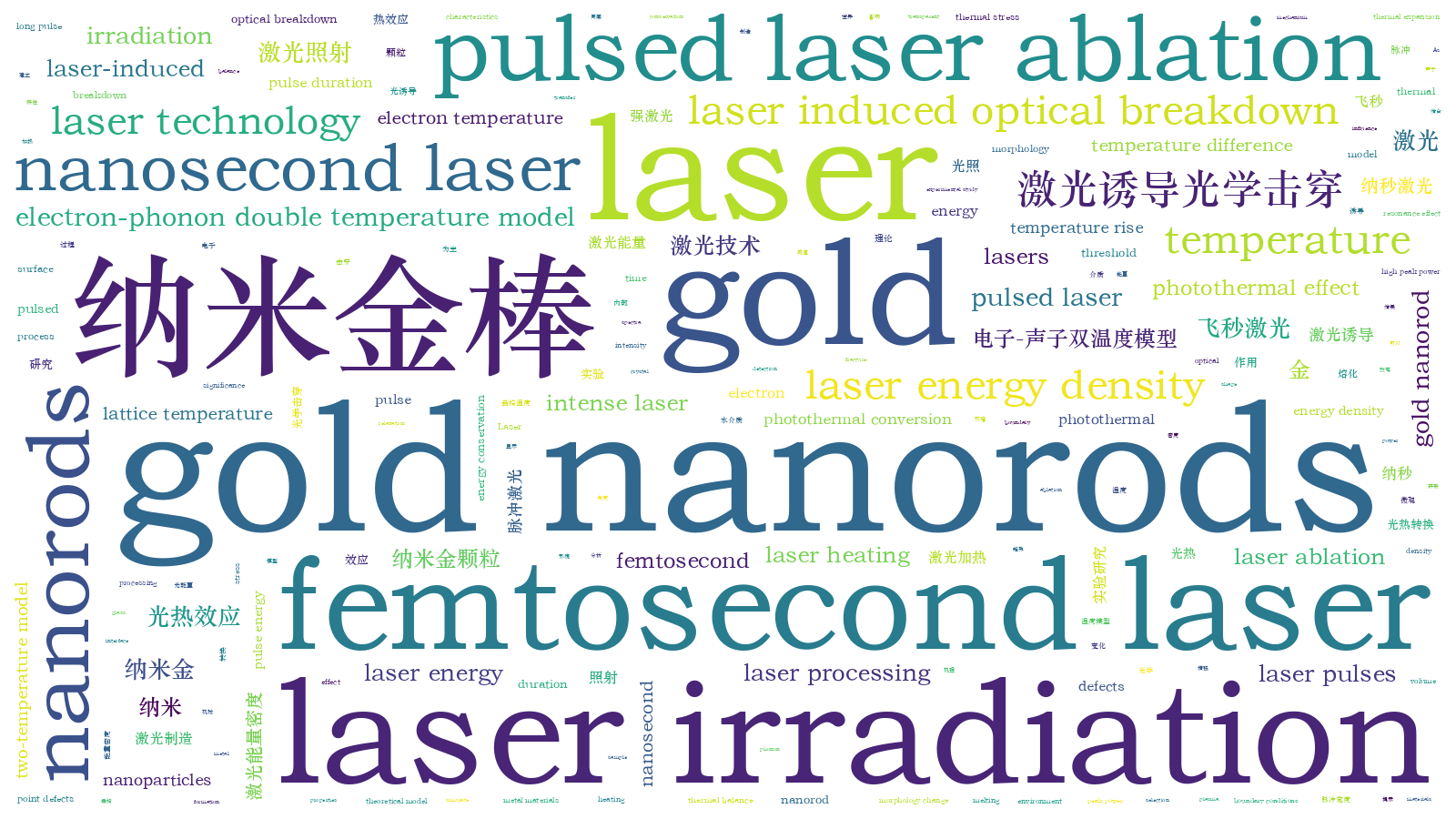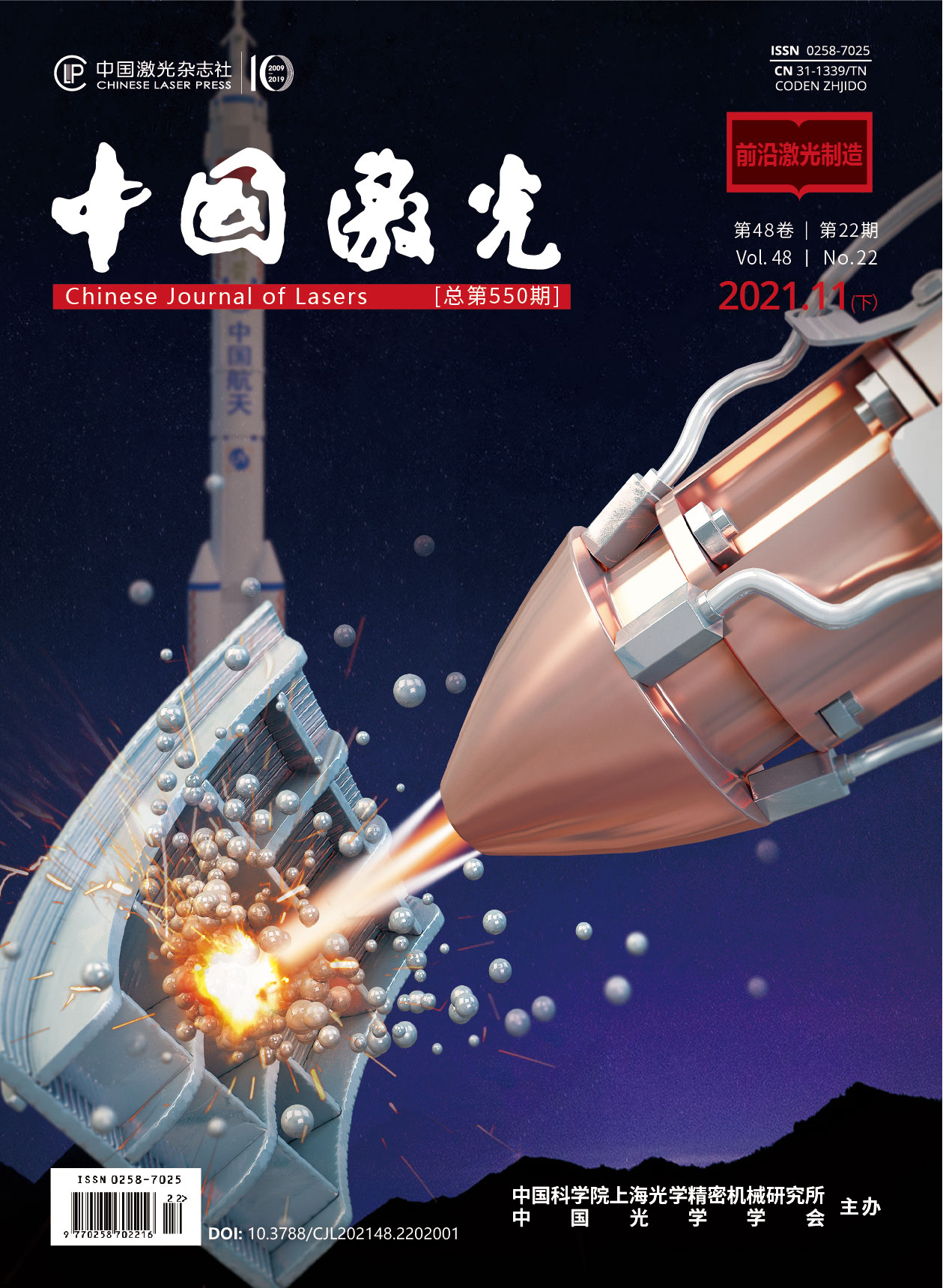纳秒与飞秒激光作用下纳米金棒光热效应的理论与实验研究  下载: 919次
下载: 919次
Objective At present, laser-induced optical breakdown has been widely used in biological sample detection, manipulation, laser-induced breakdown spectra and laser processing of transparent media (glass, etc.). Using the local plasma resonance effect of gold nanoparticles, the laser-induced optical breakdown effect can be enhanced by gold nanoparticles. Under the laser irradiation with strong pulse energy, the morphology of gold nanoparticles may gradually change into irregular spheres with sharp angles and convex edges, leading to significant changes in their photothermal conversion abilities. From the microscopic point of view, it is of great guiding significance to reveal the photothermal conversion rule inside gold nanoparticles in the process of nanosecond or femtosecond laser irradiation and to explore the mechanism of the morphology change of gold nanoparticles under the action of two kinds of lasers. In this paper, a theoretical model of high intensity pulsed laser irradiation of gold nanorods is constructed to study the effects of laser energy density and pulse duration on the photothermal conversion process. Combined with the experimental study of laser irradiation of gold nanorods, the difference in the microscopic melting characteristics of gold nanorods under nanosecond or femtosecond laser irradiation is analyzed.
Methods In this paper, the electron-phonon dual temperature model under the action of laser is used to simulate the heating process of gold nanorods in water by intense laser pulses. Firstly, the basic properties of each domain are strictly defined, including the initial temperatures of gold nanorods and surrounding environment and the selection of boundary conditions for the surrounding water. The electron and lattice temperature variations are obtained by solving the governing equations based on the two-temperature model. According to the solved values of electron and lattice temperatures, we can use the energy conservation equation of water to obtain the transient changes of water temperature along the R and Z axes. By changing the pulse duration time and energy density of the laser, we can calculate the changes in lattice temperature and water temperature of the gold nanorods to compare with the experimental results.
Results and Discussions After the femtosecond laser irradiation, the free electrons in the gold nano-rods first absorb the laser energy, leading to the temperature rise of electrons. After electron-lattice relaxation, the electrons transfer heat to the lattice. Because the laser action time is short, the lattice and electrons do not reach a thermal balance, so the electron temperature is much higher than the lattice temperature. In addition, the energy has not been transferred to the surrounding environment, so the surrounding water temperature is significantly lower than that of the gold nano-rods. The pulse duration is significantly prolonged under the nanosecond laser irradiation, the temperature difference between the lattices and the free electrons in gold nanorods is significantly reduced compared with that under femtosecond laser irradiation, and the surrounding water temperature is significantly increased.
Comparing gold nanorods irradiated by nanosecond laser and those irradiated by femtosecond laser, we can find that when the gold nanorods are irradiated by 0.001 J/cm2 femtosecond laser, the gold nanorods will be melt, but at the moment, the temperature of gold nanorods around the water is far lower than the melt temperature of the gold nanorods, and the temperature difference between gold nanorods and water is as high as 1100 K. Such a large temperature difference results in that the surface and interior of the gold nanorods cannot change in thermal expansion volume at the same time. The huge internal stress is formed due to the different volume change of each part. As a result, the gold nanorod is prone to produce point defects and line defects from the inside, and these defects subsequently evolve into plane defects and then nanorods fracture. When the 0.1 J/cm2 nanosecond laser is applied to the gold nanorod and makes it melt above threshold, the gold nanorod melt temperature, the water temperature around the interface of gold nanorods and the water temperature are 550 K, far below the femtosecond laser heating threshold. The gold nanorod surface thermal stress is significantly reduced and the gold nanorods are not easily broken.
Conclusions In this paper, the theoretical and experimental studies are carried out to analyze the photothermal conversion inside gold nanoparticles and the influence on environmental media during laser irradiation from the microscopic point of view. The results show that the changes in electron and lattice temperatures under nanosecond laser irradiation are basically the same as those under femtosecond laser irradiation. However, compared with those under femtosecond laser irradiation, the temperature difference between the lattices and the free electrons in the gold nanorods is significantly reduced and the surrounding water temperature is significantly increased due to the significantly long pulse duration under nanosecond laser irradiation. Since the high peak power is favorable for the formation of defects on the crystal surface, the melting threshold of gold nanorods under femtosecond laser irradiation (about 0.001 J/cm2) is 99% lower than that under nanosecond laser irradiation (about 0.1 J/cm2). By comparing the experimental results under femtosecond and nanosecond laser irradiations on gold nanoparticles, the difference in the photothermal conversion characteristics of gold nanoparticles under different pulsed laser irradiations are further analyzed. The results show that when the temperature of the gold nanorods reaches the threshold, the shape of the gold nanorods changes under femtosecond laser irradiation, while the morphology of the gold nanorods changes under nanosecond laser irradiation. The results here have important guiding significance for the future experiments of high intensity pulsed laser ablation of metal materials.
1 引言
脉冲激光照射下的强电磁场可将材料电离击穿,这种现象称为激光诱导光学击穿(Laser induced optical breakdown, LIOB)。材料被击穿时产生等离子体,温度急剧上升,体积迅速膨胀,导致材料破坏。同时发射包含样品组分信息的光谱,通过分析等离子体光谱可以得到样品组分信息。目前,LIOB已在生物样品检测、激光诱导击穿光谱及透明介质(玻璃等)的激光加工等领域中得到了广泛应用。直径在1~100 nm之间的纳米金颗粒[1](金纳米球[2-3]、金纳米棒[4]、金纳米笼[5]、金纳米壳[6]等)具有独特的局域表面等离子体共振(Localized Surface Plasmon Resonance,LSPR)特性[7],可选择性地吸收特定波长激光的能量并转化为热能。基于这一特性,可利用纳米金颗粒介导增强LIOB效应。
近年来,关于纳米金颗粒[8]介导的激光诱导光学击穿的研究十分活跃。Arita等[9]发现,脉冲激光照射下纳米金颗粒形成的LIOB效应可实现细胞光穿孔,使治疗性外源分子进入细胞,实现靶向治疗。Nedyalkov等[10]发现,在纳米金颗粒介导下,可实现飞秒激光诱导硅基底表面纳米孔成型,实现精细化微纳加工。Boulais等[11]针对飞秒脉冲激光辐照纳米金棒,建立了 LIOB纳米金棒集**数光热转化模型,揭示了超快脉冲激光辐照下纳米金棒附近水域等离子体生成与激光能量间的对应关系。Lachaine等[12]基于激光辐照纳米金壳的集**数光热转化模型,研究了纳米金粒子空间分布设计对纳米金粒子介导LIOB 增强空化和细胞穿孔能力的影响。
纳米金颗粒介导的激光诱导光学击穿多采用纳秒或飞秒激光。在强脉冲能量照射下,纳米金颗粒的形貌可能会逐渐变成带有尖锐角和凸起边缘的不规则球形,导致其光热转换能力产生显著的变化[13]。然而现有研究多针对单一脉冲宽度开展,缺乏纳秒与飞秒激光作用下纳米金颗粒光热作用及形貌变化的对比。从微观角度出发,深入揭示纳秒、飞秒激光照射纳米金颗粒过程中颗粒内部的光热转换规律,探究两种激光作用下纳米金颗粒形貌改变的机理,对于揭示纳米金颗粒介导的光学击穿机理具有重要指导意义。因此,本文构建了强脉冲激光照射纳米金棒的理论模型,研究了不同激光能量密度和脉冲宽度对光热转换过程的影响,结合激光照射纳米金棒的实验研究,分析了纳秒和飞秒激光下纳米金棒微观熔化特性的差异,为纳米金颗粒介导的LIBO应用提供了理论指导。
2 数理模型
2.1 控制方程
当纳米金颗粒受到强脉冲激光照射时,自由电子吸收的激光能量通过电子-晶格耦合传递至晶格,最后扩散到周围的介质中。由于激光脉宽较短(与金颗粒的热弛豫时间相当),需考虑纳米金电子与晶格间的非平衡传热,因此本文采用激光作用下的电子-声子双温度模型模拟纳米金棒在水中被强脉冲激光加热的过程[14]。纳米金棒自由电子和晶格在激光辐射影响下的瞬态传热过程为
式中:Te和Tl分别为纳米金棒的电子温度和晶格温度;dt为时间间隔;Ce和Cl分别为纳米金棒的电子和晶格的热容量;V为纳米金棒的体积;τp为激光脉冲宽度;Qw为纳米金棒与周围环境的热交换量;Tm为纳米金棒的熔化温度;g为计算传热的耦合因子;Eabs为纳米金棒吸收的激光脉冲能量,取决于激光强度Fpulse和纳米金棒的吸收截面积Aabs。(1)式右边第一项为电子和晶格的能量耦合,第二项为激光热源。(2)式右边第一项代表晶格和电子的能量耦合,第二项为纳米金棒和周围环境的热交换。其中Eabs的表达式为
当纳米金颗粒被等离子体频率光线照射时,其有效吸收截面Aabs远大于几何吸收截面,可由离散偶极子近似理论(DDA)计算,过程详见文献[ 15]。
Qw为从纳米金棒到其周围环境的热损失率,可通过下式计算:
式中:Tw为纳米金棒表面的水温;G为纳米金棒/流体界面的热导率;As为纳米金棒的表面积。热导率G将界面处的温差与穿过界面的热通量相关联,G=1.05×108 W·m-2·K-1[16]。
纳米金棒周围水的能量守恒方程采用圆柱坐标形式下的导热模型:
式中:ρw为水的密度;cp,w为水的比热容; R为径向距离;Z为纵向高度;k为电子热导率;t为激光作用时间。水和纳米金颗粒的能量方程通过热导率G实现耦合。
2.2 几何建模与网格划分
本文利用Comsol仿真软件,模拟了纳米金棒在水中被强脉冲激光加热的过程,研究了脉冲强度和脉宽等参数对纳米金棒内部光热转换和周围水传热过程的影响。参考典型双光子激光诱导击穿光谱成像[17],本文计算采用的纳米金棒尺寸为48 nm×14 nm。纳米金棒中心截面如

图 1. 纳米金棒的形状与网格划分。(a)形状;(b)计算区域;(c)网格划分
Fig. 1. Shape of gold nano-rod and meshing. (a) Shape; (b) computing region; (c) meshing
2.3 初始条件和边界条件
双温度模型的控制方程(1)、(2)式分别用修正的欧拉方法进行数值求解。周围水的能量方程(5)式通过有限容积法进行空间离散,采用隐式格式进行时间离散,以获得时间和空间上的二阶精度。模拟中取环境和纳米金棒的初始温度为293 K,周围的水采用第二类边界条件。在进行数值计算以前,对计算区域的网格进行独立性考核,最终采用0.032 nm的网格和1 fs、1 ns的时间步长分别进行纳米金棒温度和水温的计算。水和纳米金的热物性如
表 1. 水和纳米金棒的热物性参数
Table 1. Thermophysical parameters of water and gold nano-rod
|
3 模拟结果与讨论
3.1 模型的有效性验证
基于纳米金颗粒的电子-声子双温度模型,选定相应的初始值和物性参数,即可求解纳米金和周围水介质的温度场。文献[
17]模拟了单个纳米金棒(48 nm×14 nm)在水介质中被760 nm飞秒激光辐照后纳米金棒电子和晶格温度以及周围的水温,其结果可用来验证本文模型的有效性。对比结果如
从
3.2 激光脉冲宽度和强度的影响
利用 (1)~(5) 式可分别计算和对比不同脉宽激光与纳米金颗粒间的光热转化特性,并可研究激光参数包括脉冲强度、脉宽等对纳米金棒形貌的影响。根据本课题组前期研究结果[15],48 nm×14 nm的纳米金棒在800 nm激光照射下将获得最高光吸收。选取两种典型激光脉冲宽度即100 fs和7 ns,纳米金棒和周围水的初始温度设置为293 K。
首先研究飞秒激光照射下纳米金棒的光热转化特性,在脉宽为100 fs、入射能量为0.002 J/cm2的激光照射下纳米金棒电子和晶格与周围水的温度场分布如

图 3. 激光能量密度为0.002 J/cm2时纳米金棒的温度分布。(a)晶格温度;(b)电子温度
Fig. 3. Temperature distributions of gold nano-rod at laser energy density of 0.002 J/cm2. (a) Lattice temperature; (b) electron temperature

图 4. 不同飞秒激光入射能量下的纳米金棒晶格温度分布。(a)沿Z轴;(b)沿R轴
Fig. 4. Lattice temperature distributions of gold nano-rod under different incident femtosecond laser energies. (a) Along Z axis; (b) along R axis
为了与飞秒激光进行对比,本文模拟了纳秒激光照射下纳米金棒的光热转化特性。在脉宽为7 ns、入射能量为0.8 J/cm2的激光照射下,纳米金棒电子和晶格与周围水的二维温度场分布如

图 5. 激光能量密度为0.8 J/cm2时 纳米金棒的温度分布。(a)晶格温度;(b) 电子温度
Fig. 5. Temperature distributions of gold nano-rod at laser energy density of 0.8 J/cm2. (a) Lattice temperature; (b) electron temperature
纳米金棒晶格温度沿Z轴和R轴的分布随纳秒激光入射能量的变化如

图 6. 不同纳秒激光入射能量下的纳米金棒晶格温度分布。(a)沿Z轴;(b)沿R轴
Fig. 6. Lattice temperature distributions of gold nano-rod under different incident nanosecond laser energies. (a) Along Z axis; (b) along R axis
4 模拟结果与文献实验结果的对比分析
将本文模拟结果与文献[ 14]中的实验结果进行对比,进一步说明不同脉宽激光照射下纳米金颗粒光热转化特性的差异。文献[ 14]使用波长为800 nm,脉冲宽度分别为7 ns和100 fs的激光照射纳米金棒。纳米金棒采用电化学法制备,照射前后的光谱特性和形貌分别由紫外-可见-红外光谱仪和透射电子显微镜(TEM)表征,制备的纳米金棒尺寸为44 nm×11 nm。上述实验所使用的激光参数与本文模拟参数相同,纳米金棒尺寸与本文接近。
![不同激光能量密度纳秒激光照射后纳米金棒的TEM图[14]。(a) 0.64 J/cm2;(b) 0.8 J/cm2;(c) 4 J/cm2;(d) 16.7 J/cm2](/richHtml/zgjg/2021/48/22/2202014/img_7.jpg)
图 7. 不同激光能量密度纳秒激光照射后纳米金棒的TEM图[14]。(a) 0.64 J/cm2;(b) 0.8 J/cm2;(c) 4 J/cm2;(d) 16.7 J/cm2
Fig. 7. TEM images of gold nano-rod irradiated by nanosecond laser with different laser energy densities [14]. (a) 0.64 J/cm2; (b) 0.8 J/cm2; (c) 4 J/cm2; (d) 16.7 J/cm2
![不同激光能量密度飞秒激光照射后纳米金棒的TEM图[14]。(a) 0.0002 J/cm2;(b) 0.001 J/cm2;(c) 0.56 J/cm2;(d) 10.2 J/cm2](/richHtml/zgjg/2021/48/22/2202014/img_8.jpg)
图 8. 不同激光能量密度飞秒激光照射后纳米金棒的TEM图[14]。(a) 0.0002 J/cm2;(b) 0.001 J/cm2;(c) 0.56 J/cm2;(d) 10.2 J/cm2
Fig. 8. TEM images of gold nano-rod irradiated by femtosecond laser with different laser energy densities [14]. (a) 0.0002 J/cm2; (b) 0.001 J/cm2; (c) 0.56 J/cm2; (d) 10.2 J/cm2
上述实验结果可以根据本文模拟结果进行初步阐述。从
在实验中选用飞秒和纳米激光照射纳米金棒时,选用的激光能量密度略高于模拟结果。一方面,模拟中并未考虑激光透过水溶液所发生的能量耗散;另一方面,实验中激光作用于纳米颗粒群,激光能量密度需求显然高于单颗粒。
5 结论
从微观角度分析了激光照射纳米金颗粒过程中颗粒内部的光热转换和对环境介质的影响,阐明了不同激光参数下纳米金棒微观熔化特性的差异。结果表明:在纳秒激光照射下,纳米金棒内部的电子和晶格温度的变化趋势与飞秒激光照射下的情况基本一致。但由于纳秒激光照射下脉冲宽度显著延长,因此相比于飞秒激光照射,纳米金棒内晶格与自由电子的温差显著降低,而周围水温显著增高。由于在更高的峰值功率下晶面容易产生缺陷,飞秒激光照射纳米金棒熔化的阈值(约为0.001 J/cm2)比纳秒激光照射时(约为0.1 J/cm2)降低了99%。通过对比飞秒和纳秒激光照射纳米金棒的实验,进一步分析了不同脉冲激光照射下纳米金颗粒光热转化特性的差异。结果表明,当纳米金棒温度达到阈值时,飞秒激光照射纳米金棒是通过碎裂的形式发生形状改变,而纳秒激光照射纳米金棒则是通过热熔化的形式发生形貌变化。研究结果对强脉冲激光烧蚀金属材料实验有很重要的指导意义。
[1] 邢林庄, 李东, 陈斌, 等. 纳米金胶体的制备及其对血液光吸收性的影响[J]. 中国激光, 2015, 42(6): 0604002.
[2] Lv H, Xu D, Henzie J, et al. Mesoporous gold nanospheres via thiolate-Au(i) intermediates[J]. Chemical Science, 2019, 10(26): 6423-6430.
[3] 姚翠萍, 张镇西. 激光参数对纳米金靶向细胞膜通透性的影响[J]. 光学学报, 2009, 29(6): 1609-1615.
[4] Ruff J, Steitz J, Buchkremer A, et al. Multivalency of PEG-thiol ligands affects the stability of NIR-absorbing hollow gold nanospheres and gold nanorods[J]. Journal of Materials Chemistry B, 2016, 4(16): 2828-2841.
[5] Sun H P, Su J H, Meng Q S, et al. Cancer cell membrane-coated gold nanocages with hyperthermia-triggered drug release and homotypic target inhibit growth and metastasis of breast cancer[J]. Advanced Functional Materials, 2020, 30(15): 1910230.
[6] Shabaninezhad M, Ramakrishna G. Theoretical investigation of size, shape, and aspect ratio effect on the LSPR sensitivity of hollow-gold nanoshells[J]. The Journal of Chemical Physics, 2019, 150(14): 144116.
[7] Ghosh S K, Pal T. Interparticle coupling effect on the surface plasmon resonance of gold nanoparticles: from theory to applications[J]. Chemical Reviews, 2007, 107(11): 4797-4862.
[8] 杨玥, 翁国军, 赵婧, 等. 纸质表面增强拉曼散射基底的制备及其应用进展[J]. 中国激光, 2018, 45(3): 0307011.
[10] Nedyalkov N N, Miyanishi T, Obara M. Enhanced near field mediated nanohole fabrication on silicon substrate by femtosecond laser pulse[J]. Applied Surface Science, 2007, 253(15): 6558-6562.
[11] Boulais É, Lachaine R, Meunier M. Plasma-mediated nanocavitation and photothermal effects in ultrafast laser irradiation of gold nanorods in water[J]. The Journal of Physical Chemistry C, 2013, 117(18): 9386-9396.
[12] Lachaine R, Boutopoulos C, Lajoie P Y, et al. Rational design of plasmonic nanoparticles for enhanced cavitation and cell perforation[J]. Nano Letters, 2016, 16(5): 3187-3194.
[13] Ercolessi F, Andreoni W, Tosatti E. Melting of small gold particles: mechanism and size effects[J]. Physical Review Letters, 1991, 66(7): 911-914.
[14] Link S, Burda C, Nikoobakht B, et al. Laser-induced shape changes of colloidal gold nanorods using femtosecond and nanosecond laser pulses[J]. The Journal of Physical Chemistry B, 2000, 104(26): 6152-6163.
[15] Xing L, Li D, Chen B, et al. Enhancement of light absorption by blood to Nd: YAG laser using PEG-modified gold nanorods[J]. Lasers in Surgeryand Medicine, 2016, 48(8): 790-803.
[16] Plech A, Kotaidis V, Grésillon S, et al. Laser-induced heating and melting of gold nanoparticles studied by time-resolved X-ray scattering[J]. Physical Review B, 2004, 70(19): 195423.
[17] Ekici O, Harrison R K, Durr N J, et al. Thermal analysis of gold nanorods heated with femtosecond laser pulses[J]. Journal of Physics D: Applied Physics, 2008, 41(18): 185501.
Article Outline
赵鹏辉, 冯璟, 邢林庄, 李东, 陈斌, 廖丁莹. 纳秒与飞秒激光作用下纳米金棒光热效应的理论与实验研究[J]. 中国激光, 2021, 48(22): 2202014. Penghui Zhao, Jing Feng, Linzhuang Xing, Dong Li, Bin Chen, Dingying Liao. Theoretical and Experimental Investigations on Photothermal Effect of Gold Nanorods Irradiated by Femtosecond or Nanosecond Laser[J]. Chinese Journal of Lasers, 2021, 48(22): 2202014.

![仿真结果与参考文献[17]结果的对比](/richHtml/zgjg/2021/48/22/2202014/img_2.jpg)





